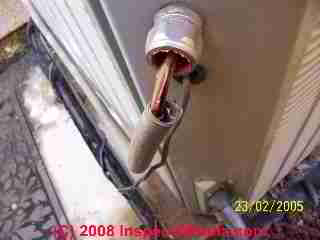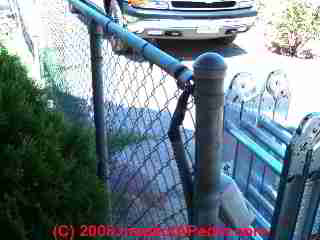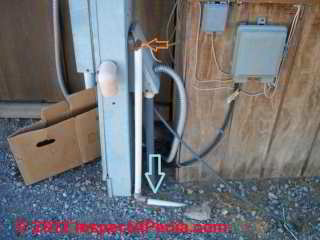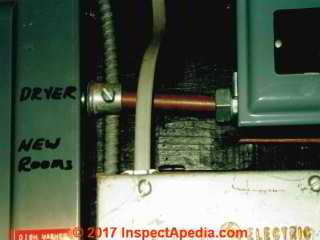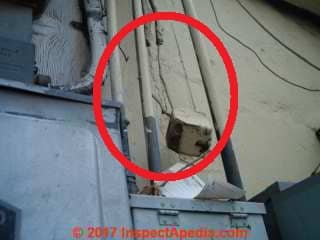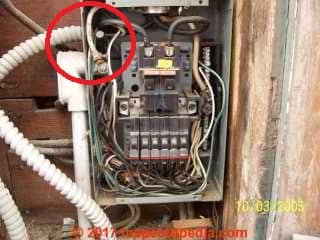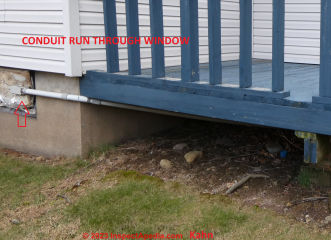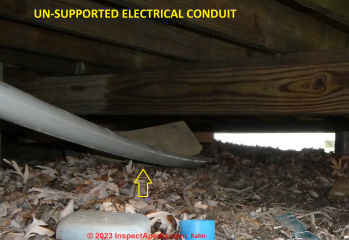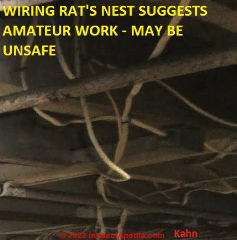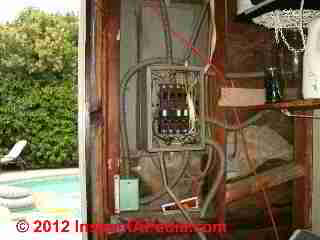 Electrical Conduit Damage
Electrical Conduit Damage
Defects in electrical conduit
- POST a QUESTION or COMMENT about electrical conduit in buildings
Electrical Conduit inspection for damage or defects:
Here we describe common errors found at electrical conduit installations including physical damage, improper installation, improper wiring, use of wrong materials. Any of these can create an unsafe condition risking electrical shock or fire.
This article series describes both metallic electrical conduit and plastic or non-metallic electrical conduit products, and answers basic questions about installing electrical conduit. Electrical conduit is metal or plastic rigid or flexible tubing used to route electrical wires in a building.
The page top photo showing rigid conduit used to bring wires up to an electrical sub-panel was provided courtesy of Tim Hemm.
InspectAPedia tolerates no conflicts of interest. We have no relationship with advertisers, products, or services discussed at this website.
- Daniel Friedman, Publisher/Editor/Author - See WHO ARE WE?
Electrical Wiring Conduit Defects Found by Visual Inspection

If our inspection is limited to an external, visual inspection of electrical conduit, we may not immediately be able to see safety and electrical code violations such as use of improper wire type or too many wires in a conduit, but here are some easy to spot concerns that merit further review by an expert:
We often see a free-standing electrical junction box, perhaps holding an electrical receptacle, which has been struck and broken off from impact.
The outdoor electrical receptacle resting on its back (photo above) has broken off from its mount, exposed wires, possibly nicked their insulation to create an immediate fatal shock hazard, and, if you click to enlarge the photo you'll see that the rigid metal conduit was badly rusted: I suspect water is entering this wiring system.
If this circuit is GFCI protected I'd expect or at least hope for it to be OFF in the tripped position.
[Click to enlarge any image]
While electrical conduit can provide superior protection for electrical wiring, rigid conduit is also vulnerable to impact damage.
Look for conduit which has been bent, dented, crimped, cut, or broken.
Tim Hemm's photo at left shows how easily a rigid conduit mounted outdoor electrical receptacle can be kicked over and broken. This condition adds the risk of a nicked or cut wire insulation making an immediate risk of electric shock or electrocution.
Leaks into electrical conduit can occur where improper fittings are used or where the conduit is damaged.
See ELECTRICAL WIRE STRIPPING TIPS for details on proper preparation of flexible conduit, metallic cable (MC) or "BX" cable, or armored cable (AC) wiring.
Even flexible conduit, such as the one shown in Tim Hemm's photo at left can be damaged by impact or pulling on the conduit. Such an open conduit line invites water entry, short circuits, and unsafe conditions.
Improper materials used as electrical conduit: only tubing which has been approved (NEC) and listed (UL, CSA) should be used for routing electrical wires.
Watch out: In Tim Hemm's photo shown above some fool has used metal fence piping to run electrical wires, risking electrocuting someone who simply touches the fence.
Above: Tim Hemm's photo illustrates a do-it-yourself and improper PVC conduit termination (orange arrow) and a damaged, disconnected plastic conduit elbow and tubing at ground level (blue arrow). [3] at REVIEWERS
Below: another do-it-yourself electrical conduit job sports copper water piping used as electrical conduit between two electrical sub panels. This is not a listed, nor approved, nor safe electrical installation.
This website provides information about a variety of electrical hazards in buildings, with articles focused on the inspection, detection, and reporting of electrical hazards and on proper electrical repair methods for unsafe electrical conditions.
Below: an improper indoor-rated electrical box? broken off from a mount on conduit outside, hanging by wires.
Below: flexible condut stuck into an electrical panel, no connector.
Home Inspection Finds Amateur Electrical Conduit Work
These photos of a 1920's home in Suffern, New York, provided by New Jersey home inspector DovBer Kahn, illustrate enough questionable electrical work that we would suggest to a home buyer or homeowner that electrical work was performed by someone untrained in proper electrical wiring and possibly done without permits and inspections.
Above: before even entering the home we see a questionable electrical conduit installation: run through fiberglass insulation stuffed into the opening of a basement window.
Below: the plastic electrical conduit continues, un-supported, below a wood deck
And the conduit continues to the building exterior, but on top of the ground, subject to damage: what happens when the lawn mower bangs into this plastic electrical conduit?
Continuing the inspection indoors we see a broken conduit joint at the electrical panel:
There's a yellow "job done right" sticker on the electrical panel.
Really? In our opinion, despite the wording on the sticker, we'd say this is a "job done wrong", and "Job done without proper electrical permits and inspections".
But beware: sometimes the electrical inspector so trusts a contractor that the work is not inspected, even if done by the contractor's trainee and without supervision. Or by the homeowner.
And looking at the basement ceiling, a rat's nest of un-supported, tangled NMC electrical wiring.
Bottom line: inspections or not, the wiring is amateur, sloppy, and raises worries about other safety concerns. This sort of evidence is a red flag to be alert for what other in-expert and possibly expensive (to repair) or unsafe work has been done on the home.
- Dov Ber Kahn, a home inspector in Rockland County, NY has contributed photographs of various building features to InspectApedia. Mr. Kahn is a licensed home inspector in New York and New Jersey, and can be reached at Website: Kahnbhomeinspectors, Tel: 845-445-8234, Email: kdovber@googlemail.com
...
Continue reading at ELECTRICAL CONDUIT, NON-METALLIC or select a topic from the closely-related articles below, or see the complete ARTICLE INDEX.
Or see these
Recommended Articles
- ELECTRICAL CONDUIT, METALLIC
- EMT ELECTRICAL METALLIC CONDUIT - THIN WALLED METAL CONDUIT - rigid
- FMC FLEXIBLE METAL ELECTRICAL CONDUIT - flexible
- IMC INTERMEDIATE METAL CONDUIT, THREADED & NON-THREADED - rigid
- LFMC LIQUID-TIGHT FLEXIBLE METAL CONDUIT & WHIPS - flexible, liquid tight, with wire
- RMC RIGID METAL CONDUIT - rigid
- ELECTRICAL CONDUIT, NON-METALLIC
- ELECTRICAL CONDUIT PULL BOXES
- ENT ELECTRICAL NONMETALLIC TUBING - rigid plastic conduit
- ENT & LFNC NON-METALLIC ELECTRICAL CONDUIT- flexible plastic & liquid-tight flexible plastic conduit
- ELECTRICAL CONDUIT BEND CONNECT TOOLS
- ELECTRICAL CONDUIT DEFECTS & DAMAGE
- ELECTRICAL WIRE TYPES CODES USES
- SAFETY for ELECTRICAL INSPECTORS.
- SEWER SEPTIC GAS CONDUIT LEAKS - odors carried into a home through its electrical conduit
Suggested citation for this web page
ELECTRICAL CONDUIT DEFECTS & DAMAGE at InspectApedia.com - online encyclopedia of building & environmental inspection, testing, diagnosis, repair, & problem prevention advice.
Or see this
INDEX to RELATED ARTICLES: ARTICLE INDEX to ELECTRICAL INSPECTION & TESTING
Or use the SEARCH BOX found below to Ask a Question or Search InspectApedia
Ask a Question or Search InspectApedia
Try the search box just below, or if you prefer, post a question or comment in the Comments box below and we will respond promptly.
Search the InspectApedia website
Note: appearance of your Comment below may be delayed: if your comment contains an image, photograph, web link, or text that looks to the software as if it might be a web link, your posting will appear after it has been approved by a moderator. Apologies for the delay.
Only one image can be added per comment but you can post as many comments, and therefore images, as you like.
You will not receive a notification when a response to your question has been posted.
Please bookmark this page to make it easy for you to check back for our response.
IF above you see "Comment Form is loading comments..." then COMMENT BOX - countable.ca / bawkbox.com IS NOT WORKING.
In any case you are welcome to send an email directly to us at InspectApedia.com at editor@inspectApedia.com
We'll reply to you directly. Please help us help you by noting, in your email, the URL of the InspectApedia page where you wanted to comment.
Citations & References
In addition to any citations in the article above, a full list is available on request.
- [1] Elizabeth Sluder, Montross, VA, the original author of this article, is a public school teacher who writes basic educational articles about a variety of building, construction, and other topics. Her husband, a licensed electrician, consults for her writing on electrical topics. Her articles appearing at the InspectAPedia TM Website have been edited, illustrated, and on occasion content has been added by the website author. These articles are © 2010 InspectAPedia copyright-protected, all rights reserved.
- [3] Timothy Hemm has provided photographs of various electrical defects used at the InspectAPedia TM Website. Mr. Hemm is a professional electrical inspector in Yucala, CA.
- [4] NFPA - the National Fire Protection Association can be found online at www.nfpa.org
- [5] The 2008 NEC National Electrical Code (ISBN 978-0877657903) Online Access LINK (you'll need to sign in as a professional or as a visitor)
- [6] Thomas & Betts Corporation, Memphis TN, website: www.tnb.com.
- [7] Eric Galow, Galow Homes, Lagrangeville, NY. Mr. Galow can be reached by email: ericgalow@gmail.com or by telephone: 914-474-6613. Mr. Galow specializes in residential construction including both new homes and repairs, renovations, and additions.
- "Electrical System Inspection Basics," Richard C. Wolcott, ASHI 8th Annual Education Conference, Boston 1985.
- "Home Wiring Inspection," Roswell W. Ard, Rodale's New Shelter, July/August, 1985 p. 35-40.
- "Evaluating Wiring in Older Minnesota Homes," Agricultural Extension Service, University of Minnesota, St. Paul, Minnesota 55108.
- In addition to citations & references found in this article, see the research citations given at the end of the related articles found at our suggested
CONTINUE READING or RECOMMENDED ARTICLES.
- Carson, Dunlop & Associates Ltd., 120 Carlton Street Suite 407, Toronto ON M5A 4K2. Tel: (416) 964-9415 1-800-268-7070 Email: info@carsondunlop.com. Alan Carson is a past president of ASHI, the American Society of Home Inspectors.
Thanks to Alan Carson and Bob Dunlop, for permission for InspectAPedia to use text excerpts from The HOME REFERENCE BOOK - the Encyclopedia of Homes and to use illustrations from The ILLUSTRATED HOME .
Carson Dunlop Associates provides extensive home inspection education and report writing material. In gratitude we provide links to tsome Carson Dunlop Associates products and services.


